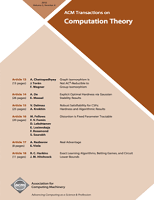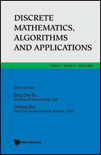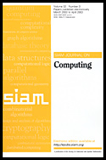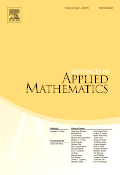
Communications in Combinatorics and Optimization
Scope & Guideline
Advancing the Frontiers of Combinatorial Research
Introduction
Aims and Scopes
- Combinatorial Optimization:
Focus on the study of optimization problems where the objective is to find the best solution from a finite set of solutions, using combinatorial structures. - Graph Theory:
Investigation of properties and applications of graphs, including domination, coloring, and spectral graph theory, which are prevalent themes in the published works. - Algorithm Development:
Emphasis on the design and analysis of algorithms for solving complex combinatorial and optimization problems, including approximation algorithms and computational complexity. - Mathematical Modeling:
Utilization of mathematical models to represent and solve real-world problems, particularly in network design, resource allocation, and scheduling. - Interdisciplinary Applications:
Application of combinatorial and optimization techniques to fields such as computer science, operations research, biology, and social sciences.
Trending and Emerging
- Multi-Objective Optimization:
Increasing focus on problems involving multiple objectives, where trade-offs between conflicting goals are analyzed, is becoming a significant area of research. - Graph Spectral Theory:
A surge in publications related to spectral graph theory, particularly concerning graph energies and indices, highlights a growing interest in the relationship between graph properties and their spectra. - Algorithmic Complexity and Efficiency:
A notable trend towards exploring the complexities and efficiencies of algorithms, particularly in the context of dominations and graph operations, showcases the need for robust computational methods. - Applications in Network Theory:
Research focusing on the application of combinatorial and optimization techniques to network structures, including traffic models and resource allocation in networks, is on the rise. - Fuzzy and Interval-Valued Graphs:
Emerging interest in the study of fuzzy graphs and interval-valued graphs reflects a broader trend towards incorporating uncertainty and flexibility into combinatorial structures.
Declining or Waning
- Classical Graph Theory:
Topics centered on traditional aspects of graph theory, such as basic graph properties and simpler algorithms, have seen a decline as more complex and applied theories gain prominence. - Elementary Combinatorial Results:
Basic combinatorial results and theorems that do not involve advanced techniques or applications are becoming less frequent, reflecting a trend toward more sophisticated and applicable research. - Static Optimization Problems:
Research focused on static or single-objective optimization problems is less common, as the trend shifts towards dynamic, multi-objective, and real-time optimization approaches.
Similar Journals

Annals of Combinatorics
Exploring the Frontiers of Discrete MathematicsAnnals of Combinatorics, published by Springer Basel AG, serves as a premier platform for innovation and research in the field of discrete mathematics and combinatorics. With an ISSN of 0218-0006 and an E-ISSN of 0219-3094, the journal captures the ongoing developments and breakthroughs that characterize this dynamic discipline, which plays a crucial role in various applications such as computer science, optimization, and statistical mechanics. The journal has been recognized as part of the Q2 category in the 2023 rankings for discrete mathematics and combinatorics, reflecting its significant contribution to the academic community. Researchers and educators alike benefit from its insightful articles that not only cover theoretical advancements but also practical implications. With convergence years spanning from 2005 to 2024, the Annals of Combinatorics continues to be an essential resource for anyone looking to deepen their understanding and explore new frontiers in combinatorial research.

Transactions on Combinatorics
Empowering Researchers with Cutting-edge FindingsTransactions on Combinatorics is an esteemed academic journal dedicated to advancing the field of combinatorial mathematics. Published by UNIV ISFAHAN, VICE PRESIDENT RESEARCH & TECHNOLOGY, this journal has been an Open Access platform since 2012, ensuring that innovative research is freely available to scholars across the globe. With an ISSN of 2251-8657 and an E-ISSN of 2251-8665, it fosters a community for researchers to disseminate their findings within the realms of Computational Theory and Discrete Mathematics. The journal has been classified in the Q4 category for both its major fields in 2023 and holds notable Scopus rankings that reflect its growing influence in the academic community, despite currently being in the lower quartiles. The journal covers a diverse range of topics from theoretical frameworks to practical applications, making it a valuable resource for researchers, professionals, and students who are passionate about combinatorics. Addressed from DEPT PRINTING & PUBLISHING MAGAZINES, HEZAR-JARIB AVE, ISAFAHAN 81746-73441, IRAN, it stands as a beacon for collaborative research and knowledge sharing in this essential field.

ACM Transactions on Computation Theory
Advancing the Boundaries of Computation Theory.ACM Transactions on Computation Theory, published by the Association for Computing Machinery, is a prestigious journal dedicated to advancing the field of computation theory and theoretical computer science. With an ISSN of 1942-3454 and an E-ISSN of 1942-3462, this journal serves as a vital resource for researchers and professionals seeking to explore groundbreaking developments in computational models, algorithms, and their mathematical foundations. The journal's rigorous standards have earned it a significant position within the academic community, as evidenced by its 2023 category quartiles, ranking in the Q1 category for Computational Theory and Mathematics and Q2 for Theoretical Computer Science. Although it operates through traditional subscription access, it maintains a critical role in disseminating cutting-edge research and fostering collaboration among experts in the United States and beyond. As an influential platform, ACM Transactions on Computation Theory is committed to contributing to the ongoing dialogue and advancement of computation theory, making it essential reading for anyone passionate about this dynamic field.

Discrete Mathematics Algorithms and Applications
Connecting Theory and Practice in Discrete Mathematics.Discrete Mathematics Algorithms and Applications, published by World Scientific Publishing Co Pte Ltd, stands as a pivotal resource in the field of discrete mathematics and combinatorics since its inception in 2009, with a convergence period extending to 2024. The journal holds an esteemed position within its category, ranked in the Q3 quartile according to latest metrics, recognized for its qualitative contributions to the academic community. With an ISSN of 1793-8309 and an E-ISSN of 1793-8317, it serves as a vital conduit for disseminating innovative research focused on algorithms and their applications within discrete mathematics. Although currently not an open access journal, it provides access to valuable insights and findings that are crucial for researchers, professionals, and students seeking to advance their understanding and application of discrete mathematical concepts. Based in Singapore, the journal continues to promote rigorous scholarly discourse and is a key publication for those involved in advancing the discipline.

SIAM JOURNAL ON COMPUTING
Unveiling Cutting-Edge Discoveries in Computing.Welcome to the SIAM Journal on Computing, a premier publication of SIAM Publications dedicated to advancing the field of computational science. Established in 1984, this journal provides a platform for groundbreaking research and theoretical advancements that shape the landscape of both Computer Science and Mathematics. With an impressive impact factor and consistently ranking in Q1 quartiles for its categories, the journal remains an essential resource for scholars looking to contribute to innovative computational theories and methodologies. Although not currently an open-access journal, the SIAM Journal on Computing offers rigorous peer-reviewed articles, ensuring high-quality contributions that appeal to researchers, professionals, and students alike. As we converge towards 2024, this journal continues to play a vital role in influencing future research directions and fostering an academic community devoted to the exploration of computational challenges. Join us in exploring the forefront of computing research!

ELECTRONIC JOURNAL OF COMBINATORICS
Exploring Innovative Solutions in Discrete MathematicsELECTRONIC JOURNAL OF COMBINATORICS, an esteemed publication in the field of combinatorial mathematics, has been a significant platform for innovative research since its inception in 1996. Published by the ELECTRONIC JOURNAL OF COMBINATORICS, this open-access journal has made its complete repository freely available since 2014, encouraging broad international collaboration and dissemination of knowledge. The journal maintains a robust reputation, boasting various category quartiles including Q1 rankings in Applied Mathematics and Discrete Mathematics, highlighting its importance in advancing research and applications in these critical fields. With a clear commitment to showcasing high-impact work and contributing to the ongoing discourse in computational theories, the journal appeals to researchers, professionals, and students alike. Scholars can access a wide array of rigorous articles that explore the latest trends and developments in combinatorial techniques, geometry, and topology, making this journal an essential resource for anyone vested in mathematical sciences. For more information, please refer to their office based at the University of Delaware, Department of Mathematical Sciences.

Contributions to Discrete Mathematics
Connecting theory and application in combinatorics.Contributions to Discrete Mathematics, published by the Department of Mathematics and Statistics at the University of Calgary, serves as a vital platform for disseminating innovative research within the dynamic field of discrete mathematics and combinatorics. Established in 2008, this journal has rapidly gained recognition, currently holding a Q3 classification in discrete mathematics and combinatorics for 2023. As it aims to foster academic dialogue and share groundbreaking discoveries, the journal showcases high-quality peer-reviewed articles that cover a range of topics, from theoretical explorations to practical applications. Although it currently operates under a traditional subscription model, there is a growing commitment to enhancing access options, ensuring that critical knowledge is available to researchers and practitioners alike. With its notable Scopus ranking of #50 out of 92 within its category, this journal is positioned as an important resource for students, academics, and industry professionals who seek to stay at the forefront of discrete mathematics research.

DISCRETE MATHEMATICS AND THEORETICAL COMPUTER SCIENCE
Pioneering Insights in Discrete Mathematics and Theoretical ComputingDISCRETE MATHEMATICS AND THEORETICAL COMPUTER SCIENCE, published by DISCRETE MATHEMATICS THEORETICAL COMPUTER SCIENCE in France, stands as a significant open-access journal since 1997, publishing innovative research articles within the intersecting disciplines of discrete mathematics and theoretical computer science. With an ISSN of 1462-7264 and an E-ISSN of 1365-8050, this journal aims to provide a platform for scholarly discourse and dissemination of knowledge, making it accessible to a global audience. It is recognized for its contributions, achieving a Q2 ranking in both Computer Science (Miscellaneous) and Discrete Mathematics and Combinatorics, alongside a Q3 ranking in Theoretical Computer Science as of 2023. The journal’s rigorous selection process ensures that only high-quality research is published, promoting advancements in these critical areas of study. Researchers, professionals, and students alike can benefit from its comprehensive articles that not only enhance theoretical understanding but also foster practical applications in the ever-evolving landscape of computer science.

Bulletin of the Iranian Mathematical Society
Elevating the discourse in mathematics, one article at a time.The Bulletin of the Iranian Mathematical Society, published by SPRINGER SINGAPORE PTE LTD, is a distinguished journal dedicated to advancing the field of mathematics. With an ISSN of 1017-060X and E-ISSN 1735-8515, this journal has established a valuable platform for researchers and scholars to disseminate their findings from 2008 to 2024. The journal is categorized in the Q2 tier of Mathematics (miscellaneous) for 2023, showcasing its importance and relevance in the mathematical community, ranked #169 out of 399 in General Mathematics with a 57th percentile standing in Scopus. While currently operating under a subscription model, it remains an essential resource for professionals and students seeking cutting-edge research and developments in various domains of mathematics. The Bulletin aims to bridge theoretical research and practical application, thereby enriching both academia and industry.

ADVANCES IN APPLIED MATHEMATICS
Illuminating the Path of Mathematical DiscoveryADVANCES IN APPLIED MATHEMATICS, published by ACADEMIC PRESS INC ELSEVIER SCIENCE, is a prestigious journal that has served the mathematical community since 1980. With its ISSN 0196-8858 and E-ISSN 1090-2074, the journal is based in the United States, specifically in San Diego, CA. As a leading periodical in the field, it holds a notable Q2 ranking in Applied Mathematics and has been consistently ranked in the 43rd percentile among similar journals, illustrating its relevance and impact within the discipline. Although not an Open Access journal, ADVANCES IN APPLIED MATHEMATICS plays a crucial role in disseminating significant research findings, theoretical studies, and innovative applications of mathematics that address real-world problems. Researchers, professionals, and students alike will find valuable insights in its carefully curated publications, making it an essential resource for those looking to advance their understanding and application of mathematics.